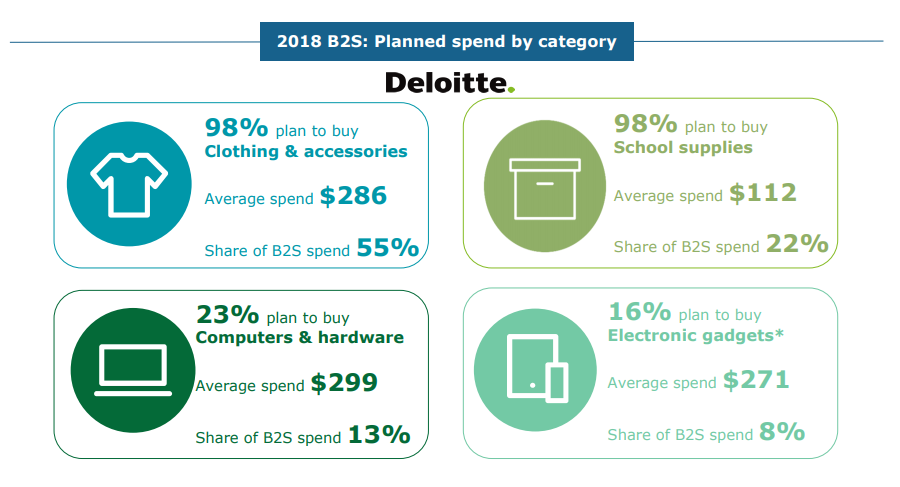2018 Back-to-School Survey: US Consumers | Deloitte
Shopping Seasons | USA
In 2017, the number of households with school going (K-12 grades) children in the US reached 29 million with 54 million children. This great segment grabs the retailers’ attention, especially during the back-to-school season. In 2018, the total back-to-school spending is expected to reach ~$27.6B, or $510 per household.
Read the below points and cast a quick glance at shopping trends for the 2018 back-to-school season in the US:
Consumer Spending on Back-to-School Trends
- Clothing & accessories (98%) and school supplies (98%) are the most planned to be purchased for back-to-school season.
- Although only 23% of back-to-school shoppers plan to buy computers & hardware, this category will grab an average spend of $299 which is more than any other category.
- In-store is the most preferred channel during the back-to-school shopping season with a rate of 57%, followed far by online channels with only 23%.
- Computers & hardware are more likely to be bought online with a rate of 40 %, while school supplies and clothing/accessories are more likely to be bought from stores with a rate of 60% for both of them.
Back-to-School Season Timing and Shopping Behavior
- 54% of back-to-school shoppers are expected to be active during the last two weeks of July, while 67% will be active during the first two weeks of August.
- Parents who begin their B2S shopping before August are likely to spend 20% more than late starters.
- Desktop/laptop devices are the most preferred devices for almost half of back-to-school shoppers, while mobile is the most preferred one for 53% of B2S shoppers.
- 23% of B2S shoppers in the US use social media during the B2S shopping season, 63% of them use it to find promotions and 59% use if to receive a coupon.
- In terms of payment methods for back-to-school shopping in the US, 57% plan to pay with their debit cards, 44% will use credit cards and 37% will use cash/check.

A Graph Shows the Planned Back to School Spend for 2018 (By Category)
Methodology:
Data is driven from 1,200 parents of school-aged children. All respondents had at least one child attending school in grades K – 12 this fall. The survey was conducted online using between May 31 and June 6, 2018. The margin of error for the entire sample of plus or minus three percentage points.

Deloitte
Warning: Undefined array key "sidebar_ads" in /home/dmc/public_html/wp-content/themes/DMC/functions/helpers.php on line 824






